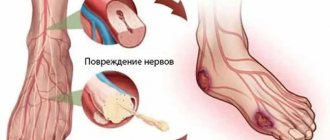Diabetes mellitus is one of the most serious health problems in the world. One of the main complications of diabetes is a blood vessel disease called diabetic angiopathy. Impaired nutrition of the nerve trunks leads to the development of another problem in patients with diabetes - neuropathy.
Diabetic angiopathy
Diabetic angiopathy is a vascular lesion that occurs in people with diabetes. In diabetes, cholesterol and calcium gradually accumulate in the walls of the arteries, which leads to their obstruction and disruption of the blood supply to the tissues.
Diabetic angiopathy is divided into two main types: microangiopathy (damage to small vessels) and macroangiopathy (damage to large main arteries), and there is often a combination of both.
Macroangiopathy develops in the vessels of the heart and lower extremities, being essentially their malignant atherosclerosis.
Microangiopathy most often manifests itself in damage to the arteries of the eyes (retinal damage - diabetic retinopathy) or kidneys (diabetic nephropathy).
Diabetic neuropathy
Diabetic neuropathy is a type of nerve damage that can occur when the vessels in the nerve trunks are affected. Diabetic neuropathy most often develops in the nerves of the legs and feet.
Depending on the affected nerves, symptoms of diabetic neuropathy can range from pain and numbness in the extremities to complete loss of sensation in the feet and hands, with the development of lesions and purulent complications.
Diabetic neuropathy is a very common complication of diabetes. However, it is often possible to prevent diabetic neuropathy or slow its progression through strict blood sugar control and a healthy lifestyle.
Information about polyneuropathy
The word "polyneuropathy" is translated from Greek as "damage to many nerves." This term very accurately describes the essence of the pathology. All structures of the body are entangled in a network of thin nerve fibers, which are divided into three groups:
- motor: responsible for motor functions;
- sensory: provide tissue sensitivity;
- Autonomous (vegetative): necessary for the unconscious regulation of the activity of certain structures, for example, blood vessels or internal organs.
Damage to certain fibers inevitably leads to disruption of their functions. The most common is mixed polyneuropathy of the lower extremities, in which symptoms of dysfunction of the sensory and motor nerves appear.
Make an appointment
Causes
Damage to peripheral nerves can occur due to the following conditions:
- diabetes mellitus: the most common cause of polyneuropathy, resulting from metabolic disorders in the myelin sheath of nerve fibers; mainly the lower extremities are affected;
- severe and prolonged deficiency of B vitamins necessary for the full functioning of the nervous system;
- infectious diseases: HIV, tick-borne borelliosis, leprosy;
- renal failure;
- alcohol abuse;
- acute and chronic intoxication, including drugs;
- autoimmune diseases: damage occurs against the background of a malfunction of the immune system; the most common are chronic and acute inflammatory polyneuropathy (Guillain-Barré syndrome);
- long stay in intensive care, for example, with extensive injuries or serious illness;
- exposure to ionizing radiation;
- pregnancy: carrying a child can cause vitamin deficiency and autoimmune lesions.
In addition, there are hereditary forms of the disease, transmitted from relatives, as well as idiopathic polyneuropathy, the cause of which cannot be determined.
Peripheral neuropathy
Peripheral diabetic neuropathy occurs predominantly in the lower extremities and is characterized by burning and painful sensations in the legs, often occurring at night, a feeling of sudden heat or cold, and pins and needles in the legs. Patients are very sensitive to touch, sometimes it is even painful. Deformations of the muscles of the limbs may be observed. Any damage. violating the integrity of the skin of the extremities become wounds that do not heal over a long period.
Kinds
Polyneuropathy is divided into several types depending on the type of fibers affected:
- sensory: the nerves that provide sensitivity are affected;
- motor: disturbances in the functioning of motor nerves are detected;
- motor-sensory: mixed form, in which motor disorders predominate;
- sensory-motor: mixed neuropathy, in which sensitivity disturbances are more pronounced;
- vegetative: first place comes to disturbances in the functioning of internal organs, changes in vascular tone and associated trophic disorders.
Significant differences in symptoms are noticeable only in the initial stages of the disease. Subsequently, all nerve fibers are involved in the pathological process, and the manifestations become mixed.
There are other types of classification of the disease:
- depending on the cause: alcoholic, diabetic, idiopathic, etc.;
- depending on the location of the lesion: polyneuropathy of the upper or lower extremities;
- depending on the type of course: acute, subacute, chronic;
- depending on the mechanism of occurrence: demyelinating (the sheath covering the nerve fibers is destroyed), axonal (formed by the death of nerve processes - axons), axonal-demyelinating.
Statistics
Polyneuropathy is the most common complication of diabetes mellitus, developing in patients with type I diabetes in 54% of cases, in patients with type II diabetes in 45% of cases. In the general structure of polyneuropathies, the diabetic variant occupies 30%.
Diabetic polyneuropathy is detected in 10% of patients who are first diagnosed with diabetes mellitus (we are talking about type II).
An asymptomatic form is often found, so almost 50% of patients diagnosed with diabetes mellitus do not report symptoms of polyneuropathy, which is detected only during instrumental studies or routine medical examinations.
Diabetic polyneuropathy in 20% of cases is manifested by severe pain, which is recognized as one of the most painful types of pain. It is the diabetic variant of polyneuropathy that is the indirect (indirect) cause of more than 50% of cases of non-traumatic amputations.
Symptoms
Symptoms of polyneuropathy depend on its cause and the characteristics of the damage to the fibers. The most common signs of pathology include:
- decreased sensitivity of the feet and palms, leading to the subjective sensation of wearing socks or gloves;
- pain in the affected limbs (sharp or dull, short-term or nagging, usually worse at rest and at night);
- spasms and twitching of muscle fibers;
- pain when touching the skin or pressing on the affected limb;
- decreased reflexes;
- increased sweating of the extremities;
- trophic disorders: swelling, changes in skin color and dryness, trophic ulcers;
- weakness of the muscles of the arms and legs, slight tremors;
- paresthesia: pathological sensations of crawling, burning, coldness;
- muscle atrophy;
- restless legs syndrome.
Alcoholic polyneuropathy
This form of the disease most often affects the lower extremities. It develops with prolonged uncontrolled consumption of alcoholic beverages and manifests itself primarily as a burning sensation and tingling sensation in the legs. With the further development of the pathology, the patient begins to feel numbness and muscle cramps, which develop due to the concomitant lack of B vitamins.
Diabetic polyneuropathy
Elevated sugar levels cause damage to the nerves of the feet (distal version) and the upper legs (proximal version). In the first case, a person experiences a characteristic set of symptoms:
- numbness and decreased pain sensitivity;
- periodic burning pain;
- muscle weakness;
- decreased reflexes;
- impaired coordination of movements, manifested by unsteadiness of gait.
The combination of polyneuropathy with damage to small vessels leads to the appearance of trophic ulcers in the lower part of the leg. The proximal version of the lesion is characterized by sharp pain in the buttock and upper thigh, as well as gradual muscle atrophy in this area.
Other problems
- Gastrointestinal problems
, especially mild symptoms of gastroparesis: mild intestinal upset, flatulence, nausea, vomiting. A light low-fat diet, limiting the consumption of fats and cell foods is necessary. If the symptoms are more severe, the endocrinologist will prescribe antibiotics, drugs that improve the functioning of the gastrointestinal tract, agents that reduce stomach acid, and other medications. - Dizziness and weakness
. The patient should avoid sudden movements such as fast walking and heavy lifting. With low blood pressure, wearing special elastic socks and stockings, salty foods and taking hormones can improve the condition. For high blood pressure, special medications are needed. In case of muscle weakness and coordination problems, physiological procedures are also used. - Urinary tract infections
. Such diseases are treated with antibiotics. To prevent urinary tract infections, it is recommended to drink plenty of fluids. If a person has urinary incontinence, they should try to go to the toilet at regular intervals, such as every three hours. - Erectile disfunction.
Men first need to rule out hormonal dysfunction by taking hormone tests. If hormones are normal, treatment for nephropathy is required. Erectile dysfunction caused by neuropathy can be treated with several methods that involve increasing blood flow to the penis. Local medications, procedures, vacuum devices, and implants are also used. - Dryness of the genital tract.
In women, neuropathy can cause vaginal dryness. In this case, vaginal lubricants are recommended.
Diagnostics
Diagnosis of polyneuropathy requires a comprehensive examination, which includes:
- survey: identifying patient complaints, clarifying the time and circumstances of the occurrence of each symptom;
- taking an anamnesis: recording all past diseases, injuries, intoxications, chronic pathologies, hereditary risk factors, etc.;
- neurological examination: assessment of skin and proprioceptive (spatial) sensitivity, motor function, muscle strength, quality of reflexes;
- consultations with specialized specialists: endocrinologist, narcologist, toxicologist, nephrologist, etc.;
- general urine test, general blood test, blood biochemistry (determination of glucose levels, lipid spectrum, vitamins and microelements, kidney function indicators and other parameters);
- blood test for HIV and other infections;
- genetic and immunological studies according to indications;
- Electroneuromyography allows you to identify lesions of nerve fibers and exclude other diseases with similar symptoms;
- biopsy of nerve and muscle tissue;
- lumbar puncture (examination of cerebrospinal fluid) to exclude neuroinfections;
- Doppler ultrasound of the vessels of the lower extremities.
The list of examinations can be adjusted depending on the form of polyneuropathy and concomitant pathology.
Treatment of polyneuropathy of the extremities
Treatment is aimed at eliminating the main cause of damage to nerve fibers, restoring their normal functioning, as well as eliminating symptoms that are unpleasant for the patient.
Depending on the cause of the disease, the following may be prescribed:
- drugs to correct blood sugar levels;
- antihistamines;
- immunoglobulins and glucocorticosteroids to eliminate inflammation and autoimmune damage;
- plasmapheresis and detoxification drugs;
- antibiotics for infections.
To restore nerve fibers, the following are used:
- B vitamins (milgamma, neuromultivit);
- drugs that improve blood circulation, metabolism and tissue regeneration: actovigin, cerebrolysin, berlition (especially effective for diabetes mellitus);
- angioprotectors: trental, pentoxifylline;
- means to enhance the conduction of nerve impulses to muscles: neuromidin.
Symptomatic therapy includes:
- non-steroidal anti-inflammatory drugs (ibuprofen, diclofenac, ketorolac), glucocorticosteroids (hydrocortisone, dexamethasone), analgesics (analgin, lidocaine) in the form of tablets, injections or local forms to relieve pain;
- anticonvulsants: tebantin, catena;
- antidepressants for chronic pain;
- sleeping pills according to indications.
Non-drug therapy is of great importance in the treatment of polyneuropathy. It includes:
- restorative and therapeutic massage to stimulate blood circulation in tissues, their nutrition and regeneration, as well as strengthen muscles;
- electrophoresis and phonophoresis with analgesics, B vitamins and other drugs (the use of electric current or ultrasonic waves facilitates the delivery of drugs to the affected area);
- electrical stimulation of muscles;
- magnetic therapy, UHF therapy, ultraviolet irradiation;
- darsonvalization: exposure to high frequency alternating current to improve metabolism and tissue regeneration;
- mud therapy: mud applications on the affected area;
- therapeutic baths with mineral waters or sea salt;
- physical therapy: dosed physical activity strengthens muscles and improves blood circulation in them; at an advanced stage of the disease, it is necessary to start with the easiest complex and gradually complicate it.
- classical acupuncture and electroacupuncture: stimulate the work of muscle tissue and nerve fibers;
- classes with an occupational therapist: necessary when it is not possible to fully restore the function of the limb; exercises are aimed at developing new movements adapted to the capabilities of the arm or leg.
For full treatment, a long-term complex effect on the affected area is required. Only if the patient thoroughly fulfills all the doctor’s instructions can success be achieved, but even in this case, full restoration of the functions of the nerve fibers is not guaranteed.
Other studies
The doctor may also consider other tests necessary:
- Electromyography
- to determine the type and extent of nerve damage. A special device sends an electrical current to the nerve, and the electromyogram shows how the muscles respond to the electrical impulses delivered through the nerves; - Heart rate variability
. The doctor must know how the heart reacts to deep breathing, exercise, blood pressure and other changes; - Ultrasound examination of the pelvis and other systems
. Using ultrasound, the structural state of organs and some functions are assessed. For example, how the bladder works.
Electromyography
Pelvic ultrasound
Complications
If you do not consult a doctor in time and do not eliminate the cause that caused the damage to the nerve fibers, neuropathy will steadily progress. Complications of the disease include:
- a significant decrease in muscle tone with subsequent muscle atrophy;
- loss of limb performance;
- development of extensive trophic ulcers requiring surgical intervention;
- loss of ability to move and self-care;
- chronic insomnia due to pain and the development of restless legs syndrome;
- depression and neuroses.
You can avoid complications if you consult a doctor for help in a timely manner and also follow preventive measures.
Make an appointment
Recommendations for foot care for diabetic nephropathy
- Wash your feet daily with warm (not hot) water and mild soap.
- Dry your ankles with a soft towel, leaving space between your toes.
- Check your feet every day for redness, sores, swelling, or fluid-filled blisters. Use a mirror to examine the back of your legs.
- Wet your feet with a special lotion, but do not apply moisturizer between your toes.
- Get rid of dry, dead skin. After swimming or showering, gently rub your heels with a pumice stone. Trim your nails promptly.
- Don't go barefoot. Wear thick, soft socks.
- Choose the right shoes—loose, well-fitted shoes that allow you to move your toes. For the first few days, wear your new shoes for an hour a day so that they take the desired shape and do not rub your feet later.
- Before getting dressed, check the inside of the shoes thoroughly - they should not be damaged, they should not have rough seams or other areas that could damage the foot and ankle.
Feet in socks
Feet care
Don't ignore even minor foot problems. Contact your endocrinologist for any abnormalities, including scratching and scratching.
Prevention
Polyneuropathy is a condition that can be effectively prevented long before the first symptoms appear. To do this you need:
- visit a doctor in a timely manner and undergo comprehensive diagnostics in order to promptly identify and eliminate diseases that can cause damage to peripheral nerve fibers;
- eliminate bad habits: smoking and drinking alcohol, prevent toxins from entering the body;
- eat well, include a sufficient amount of macro- and microelements, vitamins in the diet; For the proper functioning of nervous tissue, polyunsaturated fatty acids, which are found in vegetable oils, olives, nuts, and fatty sea fish, are especially important;
- control blood sugar and cholesterol levels;
- provide the body with regular physical activity without striving for records (walking, swimming, cycling, etc.).
Pain management
Many painkillers help relieve the pain of nephropathy. For severe pain, a combination of several medications is prescribed. Antidepressants, anticonvulsants, opioids and other medications are used for this purpose, although they all have side effects. Some of the painkillers are not recommended for older people and people with heart disease. As for over-the-counter pain relievers (paracetamol, ibuprofen), some experts advise patients not to take them because they are not enough to relieve neuropathic pain, but they have serious side effects.
Painkillers
External remedies are also used to relieve pain, especially effective for use on the ankles. The doctor may prescribe a cream containing capsaicin, lidocaine, nitrate spray, etc. In some patients, the condition is alleviated by alpha-lipolic acid, endotracheal oil and other means.
For patients with increased sensitivity to the feet and touching, for example, a blanket, a special device is used - a frame that holds the blanket in the air.
Some patients relieve pain with acupuncture, bio-communication, and physical therapy. But the effects of electrical stimulation on nerve pain, magnetic therapy, laser therapy and phototherapy have not yet been studied.
Treatment at the Energy of Health clinic
Neurologists at the Energy of Health clinic will provide assistance with any form of polyneuropathy. Specialists will conduct a full diagnosis to accurately identify the extent and location of the lesion, and then prescribe treatment and rehabilitation in accordance with the individual characteristics of the body. We use comprehensive methods that include:
- drug therapy in accordance with indications and modern recommendations for the treatment of polyneuropathy, including courses of infusions;
- various types of physiotherapy: magnetic therapy, laser and ultrasound exposure, phonophoresis and electrophoresis;
- physical therapy under the supervision of an experienced instructor, training in exercises to restore limb function at home;
- massotherapy;
- sessions with a psychotherapist if you have depression, insomnia, or increased anxiety;
- organization of sanatorium-resort treatment for complete rehabilitation.
Advantages of our clinic
The multidisciplinary clinic “Energy of Health” has experienced staff and the most modern equipment for diagnosing and treating various diseases. We provide each client with high quality medical services, which include:
- detailed examination to accurately determine the cause of complaints;
- consultations with narrow specialists directly in the clinic, as well as communication with foreign doctors if necessary;
- comprehensive treatment, selected in accordance with the indications and individual characteristics of the body;
- minor surgical operations directly in the clinic;
- own day hospital for maximum convenience;
- drawing up rehabilitation programs;
- affordable prices and services within the framework of voluntary health insurance.
Polyneuropathy is a dangerous complication of many conditions and diseases. You should not hope that the symptoms are limited to a simple tingling sensation; over time, the condition will worsen. Don’t delay seeing a doctor; sign up for a consultation with neurologists at the Energy of Health clinic.
In diabetes, the condition of the legs is primarily monitored
In nephropathy, the ankles are the first to be damaged. A diabetic should have their ankle checked at least once a year, and even more often if peripheral neuropathy is diagnosed.
A thorough ankle examination involves examining the skin, muscles, bones, circulation and sensation. Sensitivity is studied using a special brush or light pressure with a sharp object. Loss of sensation increases the risk of ankle sprains and ulcers, which can be difficult to treat if you have diabetes.
If necessary, the patient's legs perceive temperature and vibration are checked.









